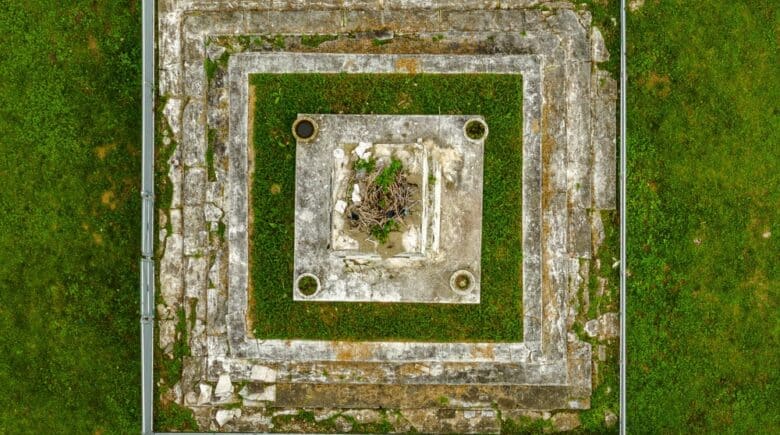Let’s embark on a journey through time as we delve into Hart Island’s rich and poignant history. Nestled in the waters surrounding New York City, this seemingly tranquil island carries a profound narrative that unfolds through the years. From its early origins as a pivotal site during times of conflict to its evolution into a resting place for the departed, Hart Island’s history is a tapestry woven with tales of resilience, remembrance, and the enduring human spirit.
History of Hart Island

Hart Island, The Bronx
Hart Island, located in Long Island Sound just off the coast of the Bronx, New York, has a complex and often somber history. It has served various purposes throughout the years, each leaving its mark on the island.
Colonial Era and Early 19th Century

Hart Island, The Bronx
The Siwanoy Native American tribe initially inhabited Hart Island before European settlers arrived. During the 17th century, it was owned by Thomas Pell, an English physician, and was known as “Minneford Island.” Later, it was sold to Oliver De Lancey and became known as “De Lancey’s Island.”
Civil War Era

An aerial, top-down view over a memorial for the dead on Hart Island
During the tense Civil War, Hart Island played an important role as a training center for Union soldiers. During the turmoil of battle, it was affectionately dubbed “Davids’ Island,” a sincere tribute to the great Colonel John David, whose steadfast commitment and leadership left an unforgettable imprint on those who fought beside him. His influence reverberates throughout history, inextricably linked to the illustrious history of this sacred site.
Late 19th Century

The tranquil but secretive beauty of Hart Island
In 1868, the City of New York purchased Hart Island and renamed it after local merchant Edward Hart. Under city control, the island became a leisure hub with attractions such as a hotel, amusement park, and racetrack. Its gorgeous setting and numerous offers make it popular for New Yorkers seeking leisure and pleasure. This time witnessed a significant shift from its previous status as a military training camp, reflecting the changing environment of the city’s recreational activities.
20th Century

Hart Island with its dilapidated buildings
As the 20th century unfolded, Hart Island underwent a transformation in its purpose, reflecting the evolving needs of society. It transitioned from its role as a training camp for Union soldiers during the Civil War to accommodate various institutions over the decades.
These included a reformatory for wayward youth, a tuberculosis sanatorium providing care for those afflicted with the disease, and even a Nike missile base during the height of the Cold War, underscoring the island’s adaptability to changing times and circumstances.
Civilian Burial Ground

An aerial, top-down View over a memorial for the dead on Hart Island
Perhaps the most significant aspect of Hart Island’s history is its role as New York City’s “Potter’s Field.” In the late 19th century, it began to be used to bury indigent, unclaimed, and unidentified individuals.
Over time, the island became the final resting place for thousands of New Yorkers, including those who died in epidemics, the homeless, and the stillborn. The city continued to use the island for mass burials, particularly during public health crises like the AIDS epidemic in the 1980s.
Controversy and Access Restrictions

Ferry to Hart Island
Hart Island’s use as a burial ground has been a subject of controversy and criticism due to its limited public access and the lack of individual gravestones for the deceased. Families seeking to visit the graves of their loved ones faced bureaucratic hurdles.
Current Status

Hart Island in the Bronx
In recent years, there have been efforts to make Hart Island more accessible and to address the concerns of families with loved ones buried there. In 2019, control of the island was transferred from the Department of Correction to the Parks Department, allowing for more public involvement in its future.
Visiting Hart Island

Hart Island
Hart Island is a place of complex history and contemplation. Its natural beauty will strike you as you approach the island by boat. The island is about one mile long and a quarter-mile wide, covered in lush greenery, with views of the Long Island Sound surrounding it.
However, as you explore the island, its somber past becomes evident. The most notable feature is the cemetery, known as the “Potter’s Field,” where thousands of individuals have been buried in mass graves over the years. Unlike traditional cemeteries, there are no individual headstones or markers. Instead, the graves are marked with simple numbered plaques.

Hart Island, nestled in the Long Island
Walking through the cemetery, you can’t help but feel the weight of its history. It serves as a poignant reminder of the city’s most vulnerable residents and their challenges in life and death.
Aside from the cemetery, there are remnants of the island’s various uses. Abandoned buildings, including the former reformatory and military structures, offer a glimpse into its past. The island’s northern tip features a beach and a pier, contrasting with the cemetery area’s solemnity.

Hart Island, among the remaining Civil War structures
Hart Island’s physical and historical isolation lends it a unique atmosphere. It’s a place where nature and history coexist, where tranquility meets solemnity. Visiting Hart Island is a sobering experience, a reminder of the city’s commitment to honoring those who might otherwise be forgotten. It’s a place to reflect on the stories of those who rest there and their life challenges. As the island’s accessibility evolves, it remains an important part of New York City’s history and a testament to the resilience of its residents.
Some Important Information to Note

Medieval castle on Hart Island
Hours: The city offers gravesite visits to Hart Island twice a month, on weekends. Gravesite visits are reserved for those people who were closest to the person who passed away, including family members, chosen family members, close friends, and partners.
Fee: All visits to Hart Island are free of charge and are authorized solely and entirely by NYC Parks. Parks does not work with third-party vendors or outside organizations to schedule or provide visits to Hart Island. All visits to Hart Island should be scheduled directly with Parks.
Visitors: Urban Park Ranger visits are open to the public and on select Tuesday mornings. Registration is required and if the tour reaches capacity, individuals will be selected by lottery. Visits to Hart Island are provided solely by NYC Parks and are free of charge to visitors.













